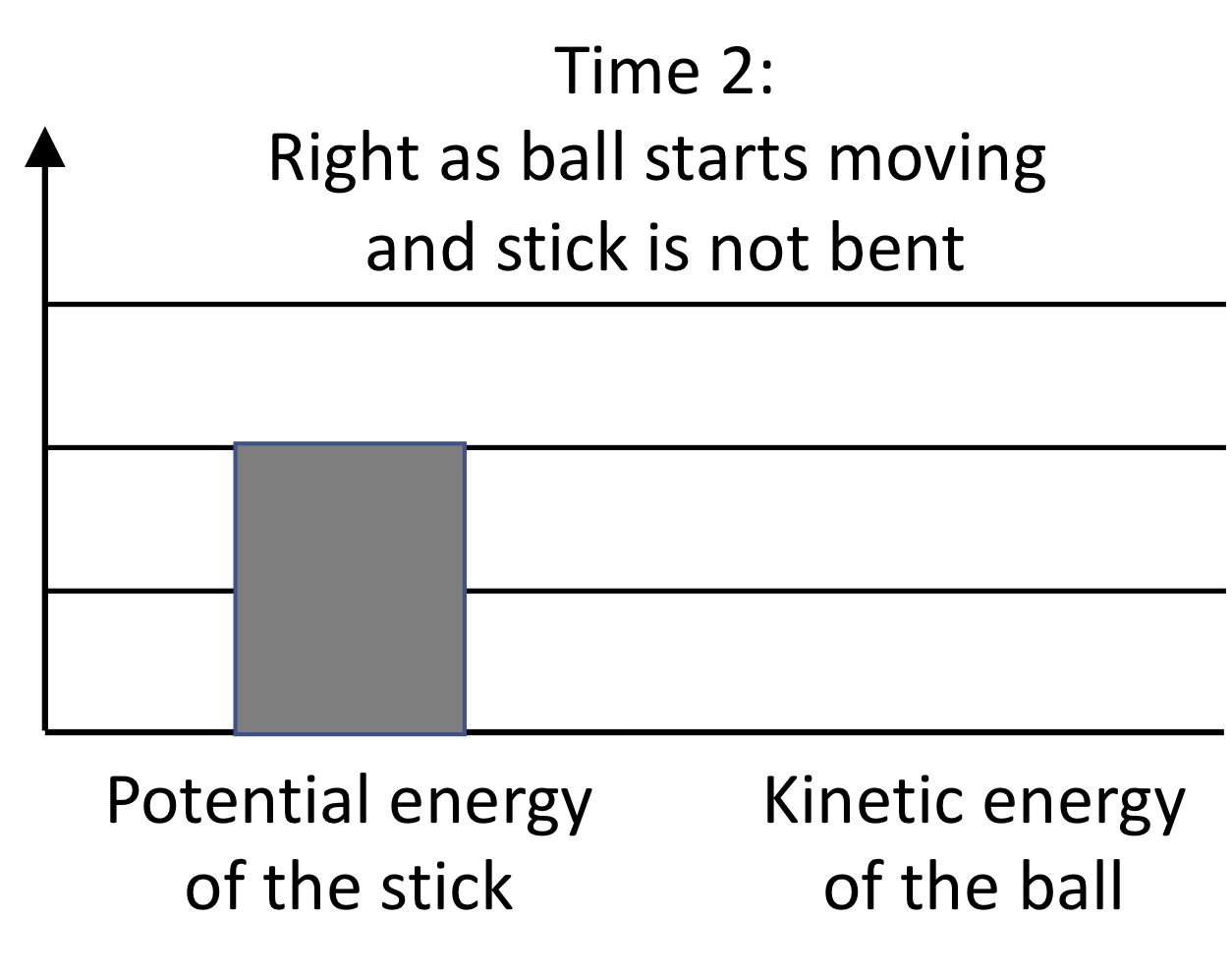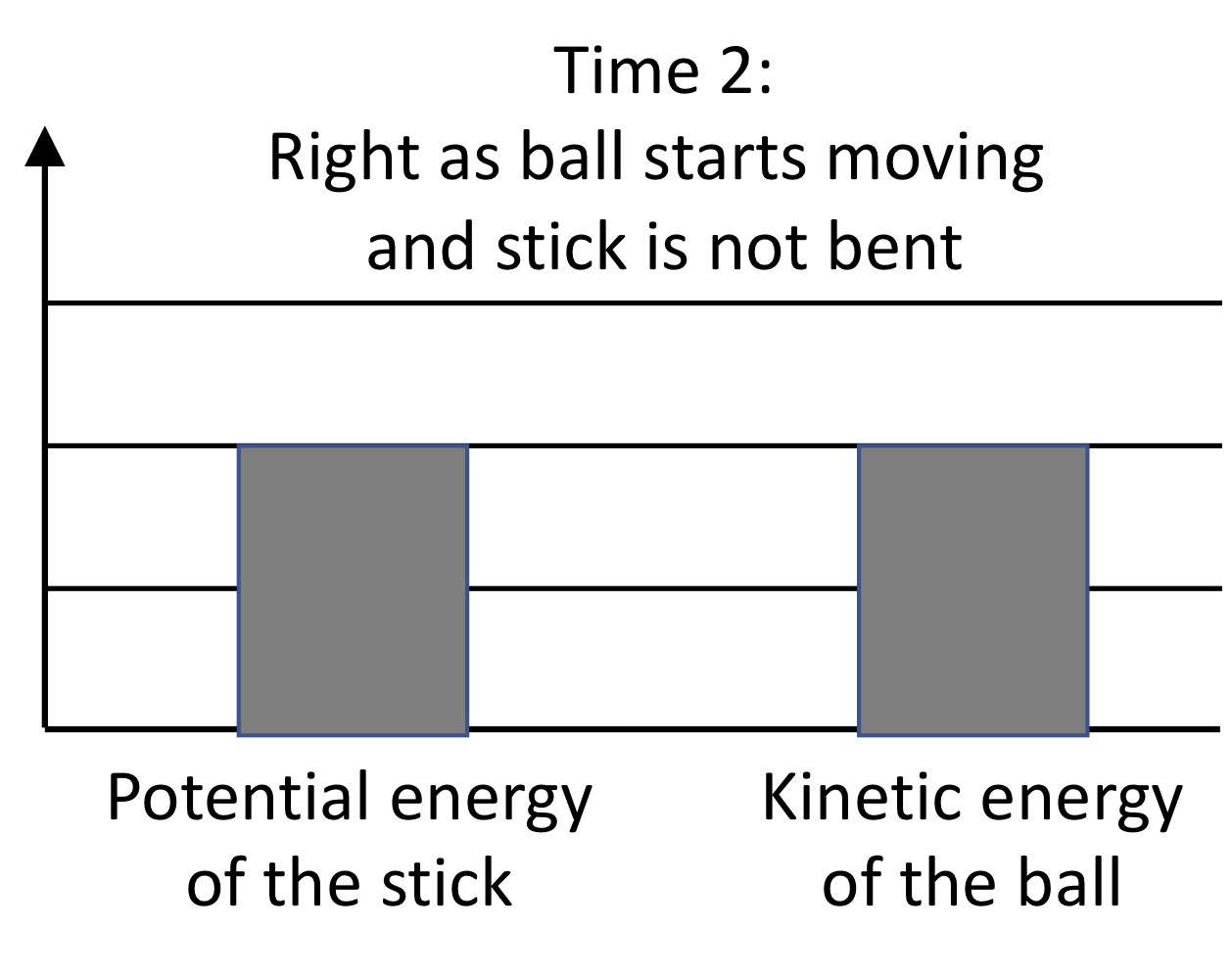Item AP012005: Design an experiment to determine how the amount a stick is bent affects how high a ball can be shot into the air and construct an argument for which trial will result in the ball traveling the highest using cause and effect relationships and ideas about energy. (MC version)
A student wants to build a catapult. A catapult is a device that can be used to launch an object into the air. To learn more about how catapults work, he makes a simple catapult. He holds a flat wooden stick at the edge of a table, places a small ball at the end of the stick, and pulls the end of the stick down before releasing it. The video below shows what happened.
The figure below shows a diagram of the ball and stick when he bends the stick (Time 1) and when he lets go (Time 2). He wants to use what he knows about energy to explain how the catapult works and figure out how to get the ball to go as high as it can.

1. He thinks about how the kinetic energy of the ball and the potential energy of the stick change when the ball is shot into the air. The bar graph below shows the amount of energy the stick and ball have while the ball is sitting on the bent stick (Time 1).

Which of the following bar graphs shows the amount of energy the stick and ball have just as the ball starts moving up and the stick is no longer bent (Time 2)?
| A. |

|
B. |

|
| C. |

|
D. |

|
2. Where does the ball get the energy to shoot up into the air when the stick is released? Explain your answer using ideas about energy transfer and evidence from the video.
After testing his simple catapult, he wants to find out if the amount the stick is bent could affect how high the ball goes into the air. He designs a simple experiment to help him answer that question. He thinks he should use the same stick and ball throughout the experiment.
3. Why is it important that the ball be the same throughout the experiment?
A. By using the same ball, you can learn which type of ball goes higher when shot into the air.
B. By using the same ball, you can learn how the amount the stick is bent affects how high you can shoot the ball into the air.
C. By using the same ball, you can learn two things. You can learn which type of ball goes higher when shot into the air. You can also learn how the amount the stick is bent affects how high you can shoot the ball into the air.
D. It is NOT important for the same ball to be used. Even if you use different balls throughout the experiment, you can still learn how the amount the stick is bent affects how high you can shoot a ball into the air.
4. What variable should he change during the experiment?
5. If you were to do this experiment, under what condition would you expect the ball to go the highest?
6. Why do you think the ball would go the highest under this condition? Explain using what you know about energy.
- Percent of Points Earned

- Points Earned
| Avg. Earned | Possible | Percent | |
|---|---|---|---|
| Q1 | 0.44 | 1 | 44% |
| Q2 | 1.23 | 5 | 25% |
| Q3 | 0.52 | 1 | 52% |
| Q4 | 0.43 | 1 | 43% |
| Q5 | 0.57 | 1 | 57% |
| Q6 | 0.65 | 3 | 22% |
- Overall Task Difficulty
| Total Points Earned | Total Points Possible | Total Percent | |
|---|---|---|---|
| 3.84 | 12 | 32% |
n = 281
Note: The total percent is a weighted average based on the total number of points earned divided by the total number of points possible.
- Science and Engineering Practices
- SEP3 Plan an investigation individually and collaboratively, and in the design: identify independent and dependent variables and controls, what tools are needed to do the gathering, how measurements will be recorded, and how many data are needed to support a claim.
SEP4 Construct, analyze, and/or interpret graphical displays of data and/or large data sets to identify linear and nonlinear relationships.
SEP6 Apply scientific ideas, principles, and/or evidence to construct, revise and/or use an explanation for realworld phenomena, examples, or events.
SEP7 Construct, use, and/or present an oral and written argument supported by empirical evidence and scientific reasoning to support or refute an explanation or a model for a phenomenon or a solution to a problem - Crosscutting Concepts
- CC2 Cause and effect relationships may be used to predict phenomena in natural or designed systems.
CC5 Energy may take different forms (e.g. energy in fields, thermal energy, energy of motion).
CC5 The transfer of energy can be tracked as energy flows through a designed or natural system. - Disciplinary Core Ideas
- PS2.A For any pair of interacting objects, the force exerted by the first object on the second object is equal in strength to the force that the second object exerts on the first, but in the opposite direction (Newton's third law).
PS3.A A system of objects may also contain stored (potential) energy, depending on their relative positions.
PS3.C When two objects interact, each one exerts a force on the other that can cause energy to be transferred to or from the object.


